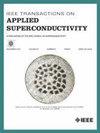Axial Tensile/Transverse Compressive Stress Characteristics of Advanced Cu-Nb Reinforced Nb3Sn Wires for 33 T Cryogen-Free Superconducting Magnet
IF 1.8
3区 物理与天体物理
Q3 ENGINEERING, ELECTRICAL & ELECTRONIC
引用次数: 0
Abstract
Nb-rod method Cu-Nb reinforced Nb3Sn wires (Cu-Nb/Nb3Sn wires) have been applied in various applications as one of high strength Nb3Sn wires and 25 T cryogen-free superconducting magnet (25 T-CSM) at Tohoku University is one of the successful examples. To further strengthen the Cu-Nb/Nb3Sn strands for a 33 T cryogen-free superconducting magnet (33 T-CSM), currently under construction at Tohoku university, we implemented the following modifications: increasing Cu-Nb fraction, niobium content in Cu-Nb and tin content in the bronze material. The strands were cabled into 16- or 18-strands Rutherford cables and pre-bent with -0.30% to +0.31% strain after heat treatment for Nb3Sn reaction. The heat treatment conditions were 670 °C × 96 h (HT-A) or 575 °C × 100 h +670 °C × 50 h (HT-B), depending on the critical current (33 T无低温超导磁体用新型Cu-Nb增强Nb3Sn丝轴向拉伸/横向压应力特性
铌棒法Cu-Nb增强Nb3Sn线(Cu-Nb/Nb3Sn线)作为高强度Nb3Sn线之一得到了广泛的应用,而日本东北大学的25t无低温超导磁体(25t - csm)就是成功的例子之一。为了进一步加强东北大学正在建设的33 T无低温超导磁体(33 T- csm)的Cu-Nb/Nb3Sn链,我们实施了以下修改:增加Cu-Nb分数,Cu-Nb中的铌含量和青铜材料中的锡含量。将钢绞线电缆成16股或18股卢瑟福电缆,并在热处理Nb3Sn反应后以-0.30%至+0.31%的应变预弯。根据磁体的临界电流(Ic)要求,热处理条件为670℃× 96 h (HT-A)或575℃× 100 h +670℃× 50 h (HT-B)。为了评估Cu-Nb/Nb3Sn线的性能,我们分别在14.5 T和4.2 K的轴向拉伸应力和横向压缩应力下测量了未电缆股和从电缆中提取股的Ic。在拉应力作用下,添加HT-A的33 T-CSM丝的Ic在251 MPa时达到峰值,在345 MPa时达到零施加应力/应变的Ic。这明显高于之前用于25 T-CSM的Cu-Nb/Nb3Sn线,后者在215 MPa时具有峰值Ic,在300 MPa时具有与零施加应力/应变相同的Ic。残余应变增加了0.049%。在横向压缩特性方面,与25根T-CSM线相比,33根T-CSM线在更高的压缩应力下保持其初始Ic值,并且布线过程没有导致33根T-CSM线的压缩应力性能下降。
本文章由计算机程序翻译,如有差异,请以英文原文为准。
求助全文
约1分钟内获得全文
求助全文
来源期刊

IEEE Transactions on Applied Superconductivity
工程技术-工程:电子与电气
CiteScore
3.50
自引率
33.30%
发文量
650
审稿时长
2.3 months
期刊介绍:
IEEE Transactions on Applied Superconductivity (TAS) contains articles on the applications of superconductivity and other relevant technology. Electronic applications include analog and digital circuits employing thin films and active devices such as Josephson junctions. Large scale applications include magnets for power applications such as motors and generators, for magnetic resonance, for accelerators, and cable applications such as power transmission.
 求助内容:
求助内容: 应助结果提醒方式:
应助结果提醒方式:


